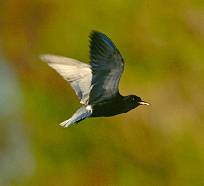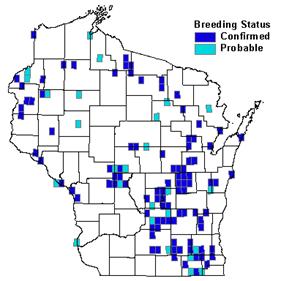Photo by Jack Bartholmai


Status/Protection
- Global Rank: G4 Key to global and state ranks
- State Rank: S3B
- WBCI Priority: SGCN, WBIRD, State Special Concern
Population Information
The Federal BBS information can be obtained at http://www.mbr-pwrc.usgs.gov/bbs/bbs.html by clicking on Trend Estimates and selecting the species in question. All estimates are for time period (1966-2005).
- Federal Breeding Bird Survey: non-significant decline
- Federal Breeding Bird Survey (WI): non-significant decline
- Federal Breeding Bird Survey (BCR 23): N/A
- Federal Breeding Bird Survey (BCR 12): N/A
- WSO Checklist Project: significant decline (1983-2007)
Life History
- Breeding Range: British Columbia east across central Canada and the northern U.S. (Dunn and Agro 1995).
- Breeding Habitat: Northern Sedge Meadow and Marsh, Southern Sedge Meadow and Marsh, Emergent Marsh.
- Nest: Floating nest surrounded by 25-75% emergent vegetative cover (Dunn and Agro 1995).
- Nesting Dates: Eggs: late May to early July (Robbins 1991).
- Foraging: Skims, hawks (Ehrlich et al. 1988).
- Migrant Status: Neotropical migrant.
- Habitat use during Migration: Freshwater lakes, rivers, interior wetlands, and flooded fields (Dunn and Agro 1995).
- Arrival Dates: Late April to late May (Robbins 1991).
- Departure Dates: Late July to late September (Robbins 1991).
- Winter Range: Central America along the Pacific coast and northern South America along the Pacific and Caribbean coasts (Dunn and Agro 1995).
- Winter Habitat: Marine and coastal areas and fresh water lakes (Dunn and Agro 1995).
Habitat Selection
Throughout their range, Black Terns prefers shallow freshwater marshes and semipermanent wetlands but also use sloughs, lake shores, river impoundments, river or island edges, river inlets, flooded sedge meadows, sewage lagoons, stock ponds, and wetlands within agricultural fields (Bent 1963, Tilghman 1980, Dunn and Agro 1995, Graetz and Matteson 1996). Ideal nest sites contain stable water levels, abundant nest substrates, and an equal proportion of interspersed emergent vegetation and open water (Tilghman 1980, Dunn and Agro 1995). In particular, sites with a 50:50 ratio of open water to emergent vegetation (i.e., the “hemi-marsh” stage) can support large numbers of nesting Black Terns (Hands et al. 1989).
The landscape surrounding wetlands may be an important factor in habitat selection. Naugle et al. (2000) found that Black Terns in South Dakota typically occurred in wetlands where <50% of the upland grasslands were tilled. Wetland size also is important. Brown and Dinsmore (1986) recorded Black Terns nesting primarily in marshes >20 ha and occasionally in smaller marshes (5.3-10.9 ha) that were part of a larger wetland complex in Iowa. In Wisconsin, Black Terns select semi-open stands of emergent vegetation and occasionally floating bogs or mud islands for nesting (Matteson 2006). Black Terns are semi-colonial nesters with colonies averaging 11-50 nests. Nests are usually 5-20m apart and typically are flimsy, floating structures susceptible to fluctuating water levels and easily destroyed by wind and high waves (Dunn and Agro 1995).
Habitat Availability
Historically, the Black Tern was widespread in Wisconsin and regarded as a common breeding species. Today, it is concentrated in east-central, southcentral, and southeastern Wisconsin. Loss of wetlands may be causing Black Terns to be more concentrated at a few suitable wetlands (Matteson and Mossman 2000). Prior to Euro-American settlement, wetlands occupied an estimated four million hectares of the total fourteen million hectares of Wisconsin’s land area. Today, 53%, or 2.1 million hectares, of these wetland habitats remain (WDNR 1995).
Agricultural drainage and urban development remain threats to wetland ecosystems and local populations of wetland-associated birds. Human activities that alter hydrology and introduce invasive plant species also threaten wetland habitats (WDNR 2003). Strict wetland use regulations and incentive programs designed to restore or enhance wetlands, such as the Partners for Fish and Wildlife Program and Wetland Reserve Program, have helped to curb habitat loss and protect existing wetlands (WDNR 1995).
Population Concerns
Breeding Bird Survey (BBS) data indicate population declines range-wide and in Wisconsin, although neither trend is statistically significant (Sauer et al. 2005). However, BBS trends may not be reliable because of this species’ semi-colonial nesting habits and the localized distribution in suitable wetland habitats. A statewide survey sponsored by the Wisconsin Department of Natural Resources (WDNR) from 1995-1997 revealed a significant decline in the state population since the last statewide survey conducted from 1980-1982. Black Terns were present on only 18% of the roadside stops compared to 43% in the 1980-82 survey. Thus, many colony sites active during the 1980-82 survey, such as Allouez Bay along Lake Superior, were no longer supporting breeding terns by the 1995-97 survey (Matteson and Mossman 2000).
Several factors have been implicated in the Black Tern’s decline, including: (1) loss of suitable habitat; (2) human disturbance; (3) reproductive failure due to predation, adverse weather, or water level fluctuations; (4) loss of winter and migratory habitat; (5) effects of contaminants or diseases; (6) inter- or intra-specific competition; and (7) invasion of exotic wetland plants (Cuthbert 1954, Bergman et al. 1970, Graetz and Matteson 1996, Matteson and Mossman 2000, Shealer 2002). Furthermore, larger colonies concentrated at fewer sites are at higher risk of local extinction through a stochastic event (e.g., disease, flood, introduced predator). Understanding this species’ annual colonization of wetlands is complicated, however, by the species’ poor site fidelity and the influence of regional wetland suitability (Shealer 2002). Thus causes of their decline remain poorly known.
Recommended Management
To provide suitable habitat in Wisconsin, managers should maintain one or more large wetland complexes in the hemi-marsh stage and stabilize water levels during the nesting season (Hands et al. 1989). In areas where water levels cannot be managed, installing artificial nesting platforms may provide a secure nest site (Dunn and Agro 1995). Nesting platforms installed at Grassy Lake (Columbia Co.) were associated with increased reproductive success in a year of extensive flooding, but care must be used to identify candidate wetlands for this type of management action (Shealer et al. 2006). Reducing predators in nesting areas may improve productivity but may not be a socially acceptable management tool (Shealer 2002). Managers also should consider restricting access near colony sites to eliminate or reduce adverse effects of human disturbance.
Conservation efforts should focus on preventing further wetland loss and degradation and restoring wetland complexes. High priority restoration sites include Rush Lake, Green Bay’s west shore, Winnebago Pool Lakes (including Lake Poygan), Horicon Marsh Wildlife Area, and Big Muskego Lake (WDNR 2005). Land acquisition, conservation easements, and enforcement of existing wetland protection regulations also will improve the status of wetland ecosystems in the state (Hands et al. 1989). Partnerships between the WDNR and organizations dedicated to wetland conservation are essential to the long-term management and conservation of wetland complexes that provide breeding habitat for this species (WDNR 2005). Wherever feasible, managers should avoid using pesticides on managed wetlands to prevent reduction and contamination of food sources (fish or insects; Hands et al. 1989).
Research Needs
Research needs for Black Terns include: (1) determine the causes of nest failure and mortality at nesting colonies; (2) further evaluate the effectiveness of artificial nest platforms; (3) determine nest-site and colony-site fidelity and factors that affect them; (4) examine effects of human disturbances; (5) determine the effects of contaminants on chick, juvenile, and adult survival; (6) identify factors affecting renesting after nest failure; (7) determine foraging range and habitat use at breeding sites; (8) determine movements, mortality rates, and causes of mortality during non-breeding season; (9) identify migration routes and critical habitat during migration stopover sites; (10) identify critical wintering sites; and (11) coordinate comparative studies across regions, including an examination of the genetic structure of populations throughout the breeding range (TNC 1992, Dunn and Agro 1995, Matteson and Mossman 2000, Shealer 2002).
More study is needed on migration and wintering biology, including stopover times and locations, and food sources and availability (Dunn and Agro 1995). Furthermore, continued monitoring of extant colonies is needed to document long-term population trends (Matteson and Mossman 2000), and continued marking (banding) of birds for individual recognition is essential to model population dynamics, understand inter-colony movement patterns, and determine longevity.
Information Sources
- Cornell Lab of Ornithology species account: http://www.birds.cornell.edu/AllAboutBirds/BirdGuide/Black_Tern.html
- North American Breeding Bird Survey: http://www.mbr-pwrc.usgs.gov/bbs/bbs.html
- Wisconsin Breeding Bird Atlas http://www.uwgb.edu/birds/wbba/
- U.S. Fish & Wildlife Service species account: http://www.r6.fws.gov/blacktern/sacp.htm
References
- Bent, A.C. 1963. Life histories of North America gulls and tern. Dover Publications, Inc. New York.
- Bergman, R.D., P. Swain, and M.W. Weller. 1970. A comparative study of nesting Forster’s and Black terns. Wilson Bulletin 82:435-444.
- Brown, M. and J.J. Dinsmore. 1986. Implications of marsh size and isolation for marsh bird management. Journal of Wildlife Management 50:397-397.
- Cuthbert, N.L. 1954. A nesting study of the Black Tern in Michigan. Auk 71:36-63.
- Dunn, E.H. and D.J. Agro. 1995. Black Tern (Childonias niger). In A. Poole and F. Gill, eds. The birds of North America, No 147. The Academy of Natural Sciences, Philadelphia, and the American Ornithologists’ Union, Washington D.C.
- Ehrlich, P.R., D.S. Dobkin, and D. Wheye. 1988. The birders handbook: a field guide to the natural history of North American birds. Simon & Schuster, Inc. New York.
- Graetz, J.L., and S.W. Matteson. 1995. The status of Black Terns in Wisconsin, 1995. The Passenger Pigeon. 58:241-248.
- Hands, H.M., R.D. Drobney, and M.R. Ryan. 1989. Status of the Black Tern in the northcentral U.S. Report to the U.S. Fish and Wildlife Service. 15pp.
- Matteson, S.W. 2006. Black Tern. In Atlas of the Breeding Birds of Wisconsin. (N.J. Cutright, B.R. Harriman, and R.W. Howe, eds.) The Wisconsin Society for Ornithology, Inc. 602pp.
- Matteson, S.W. and M.J. Mossman. 2000. Changes in Wisconsin Black tern populations, 1980-1997. A report to the U.S. Fish and Wildlife Service’s Migratory Nongame Bird Program and the Wisconsin DNR.
- Naugle, D.E., K.F. Higgins, M.E. Estey, R.R. Johnson, and S.M. Nusser. 2000. Local and landscape-level factors influencing Black Tern habitat suitability. Journal of Wildlife Management 64:253-260.
- Robbins, S.D. 1991. Wisconsin birdlife: population & distribution, past & present. Univ of Wisconsin Press, Madison, WI.
- Sauer, J.R., J.E. Hines, and J. Fallon. 2005. The North American Breeding Bird Survey, Results and Analysis 1966 - 2005. Version 6.2.2006. USGS Patuxent Wildlife Research Center, Laurel, MD.
- Shealer, D.A., J.M. Buzzell, and J.P. Heiar. 2006. Effect of floating nest platforms on the breeding performance of Black Terns. Journal of Field Ornithology 77:184-194.
- Shealer, D.A. 2002. Population dynamics of black tern nesting in southeastern Wisconsin: 2002 field season report. Horicon National Wildlife Refuge Final Report.
- The Nature Conservancy (TNC). 1992. Element Stewardship Abstract for Chlidonias niger - black tern. 54 pp.
- Tilghman, N.G. 1980. The Black Tern survey, 1979. The Passenger Pigeon 42:1-8.
- Wisconsin Department of Natural Resources (WDNR). 1995. Wisconsin’s Biodiversity as a Management Issue. http://dnr.wi.gov/org/land/er/biodiversity/report.htm
- Wisconsin Department of Natural Resources (WDNR) Wetland Management Team. 2003. Reversing the loss: A strategy for protecting and restoring wetlands in Wisconsin. Wisconsin Department of Natural Resources, Madison, WI. http://dnr.wi.gov/org/water/fhp/wetlands/documents/reversing.pdf
- Wisconsin Department o
- Wisconsin Department of Natural Resources (WDNR). 2005. Wisconsin’s Strategy for Wildlife Species of Greatest Conservation Need. Madison, WI.
Contact Information
- Compiler: Dan Haskell, danhaskell@hotmail.com
- Editor: Kim Kreitinger, K.Kreitinger@gmail.com
